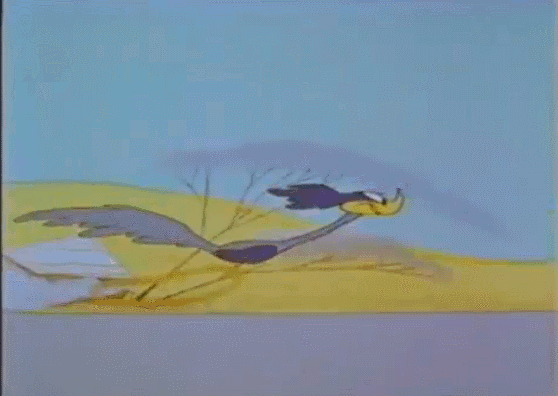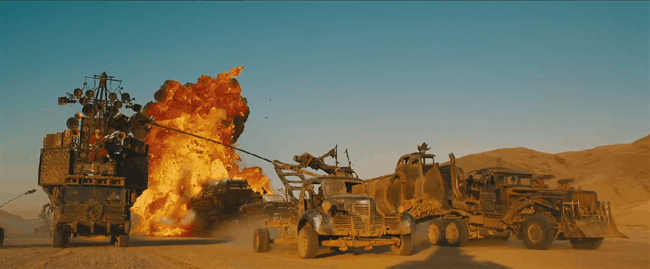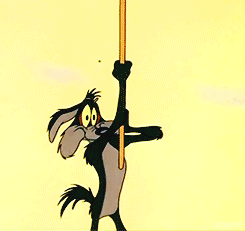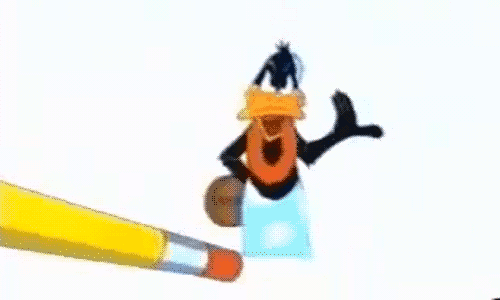MAD MAX: FURY ROAD does not look like an animated movie. Throughout the film, Charlize Theron’s Imperator Furiosa is gorgeously sweaty, her skin is granularly textured, and her face is paint-smeared. Tom Hardy as Mad Max sports levels of shaggy micro-scruff that no cartoon character could ever achieve. Large, fleshy burns dot his arms, and his face appears red, coarse, and scorched. Ash collects on everyone’s arm hairs, and oil stains their cheeks. In fact, one of the primary joys of watching the movie is that such painstaking attention has been paid to the little details that make moving human flesh look like moving human flesh: chests heave, lips parch, brows sweat, clothes itch, hands burn.
And yet, despite the oozing corporeality of the film’s protagonists, many critics have commented on its resemblance to a cartoon. These resonances are often spoken of as more structural — perhaps even spiritual — than they are stylistic. In his New York Times review of Fury Road, A.O. Scott cites the film’s debt to Chuck Jones’s Road Runner cartoons as “models of ingenuity and rigor,” while Richard Brody in The New Yorker refers to the movie as a “Rube Goldberg contraption set to the speed of a ‘Road Runner’ cartoon.” A.A. Dowd of the A.V. Club praises the movie’s “Tex Avery touches,” which he attributes to the limitless imagination of its director, George Miller, who previously worked in animation.
Early animators gave life to their drawings, endowing static figures with unique voices and movements. To animate the Road Runner, for example, was to take a relatively inexpressive grayish creature and to tint its feathers lavender, to thicken its eyelashes and enlarge its pupils, to give it a catch phrase (“beep beep”), and to grant it the powers of unparalleled hyper-speed. Once a cartoon being has been created, the distinction between the animation medium as a whole and the animated genre of the cartoon boils down to our acceptance of — and perverse pleasure in — the animator’s dual ability to create and to destroy at whim. Unlike live-action universes where human deaths are subject to build-up and consequence, the animated body is as instantly and infinitely destructible as it is instantly and infinitely reproducible. For his Road Runner cartoons, Jones famously wrote highly specific rules delineating the parameters for the obstacles that Wile E. Coyote would face in each episode, including Rule 8: “Whenever possible, make gravity the coyote’s greatest enemy.” If to animate an object is to give it life, to cartoon the same object is to play roulette with that life, for entertainment value.
Chuck Jones’s Road Runner at hyper-speed.
As a live-action film with a cartoon sensibility, Fury Road is notable for transferring not only the rule-bound integrity of the cartoon genre onto fleshy heroes and heroines, but also the physics and bodily elasticity. Just as the animated body can stretch and recoil to absorb the impact of dizzying attacks, in Miller’s film human forms are endowed with the plasticity of cartoon characters. This renders them impervious to harm, which of course means that the film throws as much harm at them as possible — extreme durability is met with extreme violence. The film’s animated texture empowers many of its characters to survive explosions, shoddy blood transfusions, and other potentially lethal obstacles. They spray-paint, brand, and pigment their skin as if it were cel paper. They catapult themselves through the air using an endlessly regenerating supply of whacked-out combat tools à la ACME corporation: vaulting poles, cool knives, guns, surprise guns, and backup surprise guns.
The cartoon physics of Mad Max.
Miller’s previous directorial credits include Babe, Happy Feet, and their sequels, and Fury Road borrows its loose road movie structure from these CGI stories. In Babe: Pig in the City, Babe leaves the farm to go to the big city, only to return to the farm. In Happy Feet, a penguin caught in troubled waters is whisked away from his home and washes up at a Marine World on the shores of Australia, where he tap dances behind glass until he earns his freedom and journeys back to his colony. Fury Road not only appropriates this basic Odyssean plot, it also simplifies it. In Babe and Happy Feet, there are dance sequences, wisecracking sidekicks, developed love stories, moments of doubt, backstories, and special talents. In Fury Road, Miller’s characters must merely get from point A to point B and back again, with only a few light backstories tossed into the narrative. In fact, the film’s brief dialogues were improvised and feel like glitches in its cartoon facade
Both Hardy and Theron have spoken with lucidity about the challenges of inhabiting cartoon bodies in Fury Road. Hardy cited Wile E. Coyote and London, the crime-fighting German shepherd of “The Littlest Hobo,” as his biggest acting influences for the movie. “Max is kind of like a dog,” he observed in an interview for io9. “Things just happen to him, and he sort of has to get through it.” While Hardy seems to have stoically submitted to becoming a flying object on screen, Theron sounds more human when describing her experience of filming Fury Road. In an interview with Esquire this April, she voiced her frustration with the unending, unstructured narrative of the script and the physical expanse of its setting: “It was like a family road trip that just never went anywhere. We never got anywhere. We just drove. We drove into nothingness, and that was maddening.”
Theron’s frustration is itself a cartoon cliché — a Looney Tunes convention, in which a character breaks the fourth wall in order to voice its exasperation and irritation toward a seemingly evil animator. Wile E. Coyote is famous for this trope: falling from a cliff face, turning to us in resignation, and holding up a sign asking for the cartoon to end. In one of the more extended versions of this gag, “Duck Amuck” (1953), Daffy Duck is an increasingly unhappy actor repeatedly asking the silent animator for understanding, for information, and, often, for things to just go somewhere, as Theron does in her interview.
Wile E. Coyote’s direct address.
“Duck Amuck” and moments in Jones’s Road Runner shorts are designed in protest of the arbitrariness of the Hollywood star system, drawing a parallel between the apparently random cruelty of the cartoon world and that of the live-action film industry. Since the early 1900s, an awareness of drawn characters as subject to their creators’ whims has informed the development of the cartoon genre. Winsor McCay’s “Gertie the Dinosaur” (1914), among the earliest and best-preserved theatrically released American animations, features live-action footage of McCay giving orders to a trained dinosaur — “Be a good girl and bow to the audience” — and ends in his drawing himself into Gertie’s world as a cartoon body, wielding a whip. The Fleischer brothers’ “Out of the Inkwell” shorts (1918–1929) open with live-action footage of Max Fleischer tugging an unwilling Koko the clown out of an inkwell, and end in protracted scenes of Koko’s creator forcefully stuffing him back in, as Koko kicks and howls. It isn’t until the emergence of the Fleischers’ Betty Boop cartoons (1930–1939) that conventions once meant to reference the abusive labor conditions of circus worlds — homes of trained fauna and grumpy clowns — are fitted to the landscape of an increasingly powerful Hollywood studio system, connecting the treatment of “circus freaks” to that of aspiring movie stars. In her shorts, Betty Boop is frequently reminded to adhere to her “contract,” and often toys with her offscreen director, “Uncle Max” Fleischer, asking him to change the script or to give her different scenery. Though in the Betty Boop cartoons, Betty and Fleischer are rarely antagonistic toward each other, 20 years later, Jones’s cartoons are more critical of the power dynamics between actor and director. In shorts like “Duck Amuck,” Jones references the many abuses that contracted stars underwent at the hands of studio heads and directors — diabolical, pre-labor law hours; contract terms with stringent weight specifications; unprotected stunts — by giving his cartoon characters the resolve to protest their predicament at the hands of their makers.
“Duck Amuck” (1953).
But Mad Max: Fury Road’s cartoon aesthetic does not incorporate or address this self-reflexive aspect of the genre’s history. Instead, Miller scrubs the cartoon conventions that his film references of their associations to any kind of industry critique, presenting them in a newly lacquered, de-problematized form. Here, the audience can fully indulge in its most basic cinematic wants — the pulse-shattering pleasures of high-speed collisions, eye candy in the form of rail-thin lingerie models — without the attendant subtext (Who is running this show? And why?) that clung to 1950s-era cartoons. The gladiatorial enterprise of the Hollywood action pic has, of course, undergone significant regulation since the time of Jones’s shorts, and we can rest assured that actors in Fury Road are most likely not criminally overworked or performing highly dangerous stunts. But what about the lingerie models?
Theron’s resistance to driving, Road Runner–like, into arbitrary, undefined “nothingness” (as compared to Hardy’s easygoing resignation of personhood in favor of acting “kind of like a dog”) reminds us that the power dynamics inherent to the animation medium, and present in Fury Road, heighten when cartoon conventions come in contact with female bodies. If to cartoon a body is to subject it to endlessly multiplying obstacles and inconveniences for the viewer’s entertainment, to cartoon is also to objectify — to make the body just live-looking enough for the audience to want it to survive, but not for us to particularly understand it or mourn its loss should it not.
Fury Road has been praised for its feminist message since its release, and Imperator Furiosa is a lot like cartooned heroines before her, from Wonder Woman to Daria. Her image is both simple and suggestive enough that it can be transferred and applied to narratives beyond the story in which it was born. Increasingly removed from her context within Fury Road’s plot, Furiosa has become the protagonist of a much broader conversation about the triumph of female characters in blockbuster cinema. Most recently, her face was splashily recolored in shades of hot pink, purple, yellow, and teal, and placed at the top of a New York Times article headlined “Hard Hitting Heroines.” The popular Tumblr “Feminist Mad Max” has also gained a devoted following by appropriating the Ryan Gosling “Hey Girl” meme and replacing it with images of Max’s dopey face addressing the Imperator. In a popular iteration of the meme, a still of Max’s face is accompanied by the words: “Hey girl. I’ve never seen such a group of varied, complex, and badass female action heroes. I’m glad to be riding with you.”
Feminist Mad Max’s words, though sweet, overstate the progressive politics of Fury Road’s cartooned universe — a universe in which all characters are objectified in order to withstand the laws of cartoon physics or perish. The rallying cry of what A.O. Scott terms the film’s “feminist guerrilla force,” a group of women on the run from a postapocalyptic misogynist society, is “We are not things!” But this choice of slogan is odd in a film where Miller might as well have said, “You are all marbles,” before releasing his characters down such an elaborately constructed chute of a movie. Far from being “varied and complex,” most of the female heroines riding in Furiosa’s rig are distinguishable primarily by their hair color. Draped in swathes of diaphanous cheesecloth, the wives are introduced by a prolonged scene in which they bathe by a spigot, as if participating in a wet T-shirt contest. Miller’s choice to cast well-known supermodels to play the wives also associates many of the female presences onscreen with their two-dimensional images in glossy magazine ads and billboards. Though Rosie Huntington-Whiteley — the most prominent wife — has already graced screens big and small in Michael Bay’s Transformers and Victoria’s Secret ads, her role in Mad Max: Fury Road does little to complicate her previous representations as a body that, though fleshy and corporeal, is never quite human.
As such, the Imperator Furiosa and her friends remain “things,” tossed from page to page of Miller’s comic flipbook. From Max, to the war boys, to the city’s villainous overlords, all the characters in this film are people with cartoon souls, who, though lovely to watch hurtling through desert landscapes, need not be cast as emblems of social change in the Hollywood action movie machine. A few months ago, after the release of Avengers: Age of Ultron, Sady Doyle wrote about the death of the popcorn movie in an age where a new Marvel or DC Comics film is churned out seemingly once a week, each an increasingly feeble impression of a tired template. Part of the overwhelmingly enthusiastic response to Fury Road as a work of aesthetic and political significance must be rooted in our collective desire to expect more from the desiccated corporate snoozefest that the action flick genre has become. In this sense, Fury Road, both in its debts to an exciting range of visual influences — not just to Looney Tunes but also to steampunk and retro-futurist design — and its seductive premise of arming women with the tools to drive themselves out of oppression, is, despite its problems, water in a desert.
But these elements alone do not explain the sheer sense of relief and surprise that has colored Mad Max’s reception. Perhaps most importantly, unlike Superman and Batman, Mad Max and Imperator Furiosa are so welcome because they do justice to the necessary sense of fun built into their comic roots. As relative no-names reborn from a forgotten Australian series, they are unburdened by the deadening gravitas that plagues the summer blockbuster superhero. They bounce and swerve in unexpected ways. At times, they even make us laugh. Ultimately, what critics talk about when they talk about Chuck Jones is his ability to entertain, and George Miller’s savvy to the movie magic locked in cartoon formulas is at the heart of Fury Road’s appeal. At best, Fury Road’s success may reveal the potential of animation conventions to expand the horizons of action flick worlds, in all their frantic magnificence, their lurches and skids.
¤
LARB Contributor
LARB Staff Recommendations
Selling Out the Newspaper Comic Strip
The comic strip and its evolution and devolution.
The Economics of Mad Max and Star Trek
Our scientific prowess and our destruction of the planet: which will be the first home to roost?
Did you know LARB is a reader-supported nonprofit?
LARB publishes daily without a paywall as part of our mission to make rigorous, incisive, and engaging writing on every aspect of literature, culture, and the arts freely accessible to the public. Help us continue this work with your tax-deductible donation today!
:quality(75)/https%3A%2F%2Fdev.lareviewofbooks.org%2Fwp-content%2Fuploads%2F2015%2F08%2FMad-Max.jpg)



